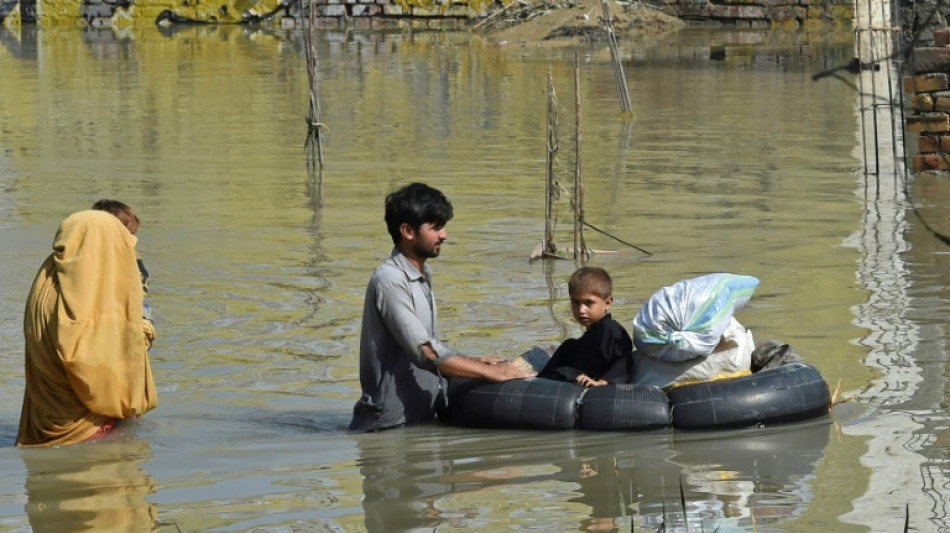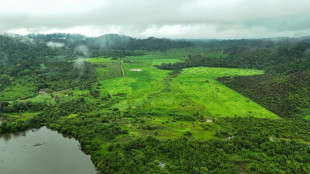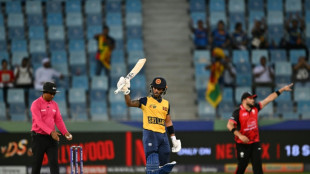
-
 2025 summer was Spain's warmest on record: weather agency
2025 summer was Spain's warmest on record: weather agency
-
Gout of this world? Australian teen sprinter set for first real test

-
 Smoke-dried bodies could be world's 'oldest mummies': study
Smoke-dried bodies could be world's 'oldest mummies': study
-
Afghan gets life in prison for jihadist knife murder in Germany

-
 Trump bringing $15 bn lawsuit against New York Times
Trump bringing $15 bn lawsuit against New York Times
-
Juan Mata moves to Melbourne from Australian rivals

-
 UN investigators say Israel committing 'genocide' in Gaza
UN investigators say Israel committing 'genocide' in Gaza
-
Israel bombards Gaza City as UN probe accuses it of 'genocide'

-
 Rubio asks Qatar to stay as mediator after Israel strike
Rubio asks Qatar to stay as mediator after Israel strike
-
Drug cheats put India Olympic bid and careers at risk

-
 East Timor police fire tear gas on second day of car purchase protests
East Timor police fire tear gas on second day of car purchase protests
-
Austria hit with fresh spy claims after govt promises law change

-
 Floods devastate India's breadbasket of Punjab
Floods devastate India's breadbasket of Punjab
-
In mega-city Lagos, 20 million count on just 100 ambulances

-
 FBI chief Kash Patel faces Senate panel
FBI chief Kash Patel faces Senate panel
-
Trump says bringing $15 bn lawsuit against New York Times

-
 Israel sets Gaza 'on fire' as Rubio warns days left for deal
Israel sets Gaza 'on fire' as Rubio warns days left for deal
-
Phillies clinch first MLB division by beating Dodgers

-
 'Nothing here': Lack of jobs forces young Nepalis abroad
'Nothing here': Lack of jobs forces young Nepalis abroad
-
Rubio asks Qatar to stay as mediator after Israeli strike

-
 Trump set for unprecedented second UK state visit
Trump set for unprecedented second UK state visit
-
Lower US tariffs on Japan autos kick in

-
 Revamped Bayern face early test as Chelsea come to town
Revamped Bayern face early test as Chelsea come to town
-
Papua New Guinea, Australia to vow mutual defence in new treaty

-
 Malawi election a battle of two presidents
Malawi election a battle of two presidents
-
Asian markets rise as traders prepare for expected US rate cut

-
 Malawi votes in a rematch between two presidents as economic crisis bites
Malawi votes in a rematch between two presidents as economic crisis bites
-
Australia says social media ban will not age test all users

-
 Poland's Nawrocki talks drone defence in Paris and Berlin
Poland's Nawrocki talks drone defence in Paris and Berlin
-
Trump's fossil fuel agenda challenged in youth climate suit

-
 PSG fear impact of injuries as they put Champions League title on the line
PSG fear impact of injuries as they put Champions League title on the line
-
US Senate confirms Trump aide to Fed as politics loom over rate meeting

-
 Papua New Guinea, Australia will commit to mutual defence
Papua New Guinea, Australia will commit to mutual defence
-
Trash, mulch and security: All jobs for troops in Washington

-
 DEEP Robotics Leads the Industrial Robot Dog Race, Demonstrating Strong Capabilities from Power Grid Inspection to Plateau Scientific Exploration
DEEP Robotics Leads the Industrial Robot Dog Race, Demonstrating Strong Capabilities from Power Grid Inspection to Plateau Scientific Exploration
-
Why Leaders Across Industries Are Trusting and Building Good Driver Mutuality

-
 Tocvan Announces Commencement Of Field Work And Airborne Magnetics Survey At Gran Pilar Gold Silver Project; Drilling And Trenching Prep Accelerate Discovery & Pilot Mine Production
Tocvan Announces Commencement Of Field Work And Airborne Magnetics Survey At Gran Pilar Gold Silver Project; Drilling And Trenching Prep Accelerate Discovery & Pilot Mine Production
-
NFL legend Brady to play in March flag football event at Riyadh

-
 Lower US tariffs on Japan autos to take effect Tuesday
Lower US tariffs on Japan autos to take effect Tuesday
-
US strikes second alleged Venezuelan drug boat as tensions mount

-
 Protesting Peru residents block trains to Machu Picchu
Protesting Peru residents block trains to Machu Picchu
-
US strikes another alleged Venezuelan drug boat as tensions rise

-
 White House vows to take on left-wing 'terror' movement after Kirk killing
White House vows to take on left-wing 'terror' movement after Kirk killing
-
Brazil's Amazon lost area the size of Spain in 40 years: study

-
 US Senate poised to advance Trump aide's appointment at Fed
US Senate poised to advance Trump aide's appointment at Fed
-
Sri Lanka survive Hong Kong scare for four wicket Asia Cup win

-
 Arab, Muslim leaders urge review of Israel ties after Qatar attack
Arab, Muslim leaders urge review of Israel ties after Qatar attack
-
Mbappe 'not anxious' over Champions League goal as Bellingham returns

-
 Huge pot of Nigerian jollof rice sets Guinness record
Huge pot of Nigerian jollof rice sets Guinness record
-
Heartbreak will help Arsenal's Champions League charge: Arteta


Pakistan floods: South Asia's monsoon explained
Floods in Pakistan have killed more than 1,000 people after what its climate change minister called a record unbroken cycle of monsoon rains with "8 weeks of non-stop torrents".
AFP explains what the monsoon is, why it is so important and yet so dangerous, and how climate change and other man-made effects may be altering the vast life-giving but destructive annual weather system.
What is the South Asian monsoon?
The Southwest or the Asian Summer Monsoon is essentially a colossal sea breeze that brings South Asia 70-80 percent of its annual rainfall between June and September every year.
It occurs when summer heat warms the landmass of the subcontinent, causing the air to rise and sucking in cooler Indian Ocean winds which then produce enormous volumes of rain.
Why it is important?
The monsoon is vital for agriculture and therefore for the livelihoods of millions of farmers and for food security in the poor region of around two billion people.
But it brings destruction every year in landslides and floods. Melting glaciers add to the volume of water while unregulated construction in flood-prone areas exacerbates the damage.
Is it the same every year?
Despite being heavily studied, the monsoon is relatively poorly understood. Exactly where and when the rain will fall is hard to forecast and varies considerably.
This year, for example, while Pakistan has seen a deluge, eastern and northeastern India reportedly had the lowest amounts of July rainfall in 122 years.
What explains the variability?
Fluctuations are caused by changes in global atmospheric and oceanic conditions, such as the El Nino effect in the Pacific and a phenomenon called the Equatorial Indian Ocean Oscillation (EQUINOO) only discovered in 2002.
Other factors are thought to include local effects such as aerosols, clouds of dust blowing in from the Sahara desert, air pollution and even irrigation by farmers.
What about climate change?
India is getting hotter and in recent years has seen more cyclones but scientists are unclear on how exactly a warming planet is affecting the highly complex monsoon.
A study last year by the Potsdam Institute for Climate Impact Research (PIK) tracking monsoon shifts from the mid-20th century suggested that it was becoming stronger and more erratic.
Initially, aerosol pollution reflecting sunlight subdued rainfall, but from the 1980s the warming effects of greenhouse gases began to drive stronger and more volatile rainy seasons, the study said.
Do other studies bear this out?
Broadly yes. The Indian government's first ever climate change assessment, released in 2020, said that overall monsoon precipitation fell around six percent from 1951 to 2015.
It said that there was an "emerging consensus" that this was down to aerosol pollution considerably offsetting the expected rise in rainfall from global warming.
With continued warming and lower aerosol emissions, it projected more rain and greater variability by the end of this century, together with "substantial increases" in daily precipitation extremes.
What will this mean for people?
India's 2021 monsoon was a case in point: June rain was above normal, in July it fell, August was nearly a drought and in September precipitation returned with a vengeance.
Several hundred died in floods in Maharashtra in July and in Gujarat in September. The same month a cloudburst turned the streets of Hyderabad into raging rivers in just two hours.
But by October farmers in parts of northern and north-eastern India were reeling from drought while elsewhere the monsoon took longer than usual to withdraw.
"More chaos in the Indian monsoon rainfall will make it harder to adapt," Anders Levermann from PIK and Columbia University told AFP last year.
M.Fischer--AMWN


